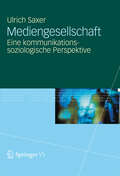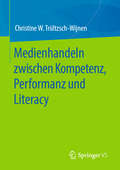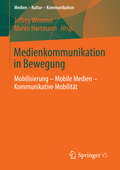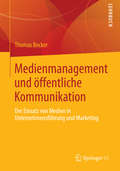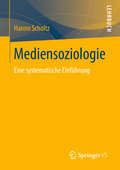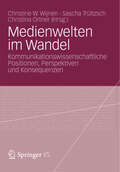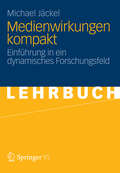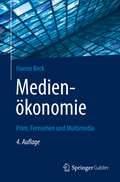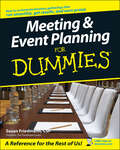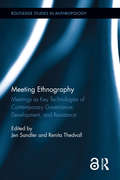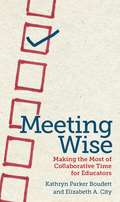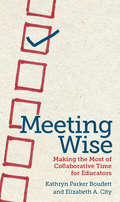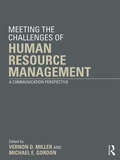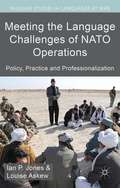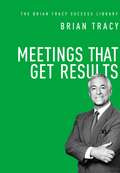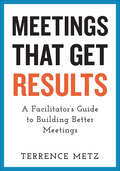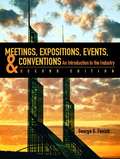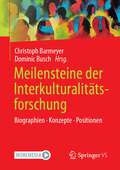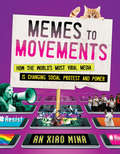- Table View
- List View
Medienhandeln zwischen Kompetenz, Performanz und Literacy
by Christine W. Trültzsch-WijnenDas Buch diskutiert die soziale und individuelle Bedingtheit von Medienkompetenz. Im Mittelpunkt steht die Frage, wie sich das Medienhandeln von Individuen im Hinblick auf deren Medienkompetenz, im Sinne eines sicheren und selbstbestimmten Handelns im Umgang mit Medien, erklären und beurteilen lässt. Dies setzt eine Betrachtung des Medienhandelns vor dem Hintergrund der Beziehungen zwischen der Kompetenz zu Handeln, als Summe von Fähigkeiten, Fertigkeiten und Wissen sowie der kognitiven Beherrschung von Regeln des Verhaltens (moralische Regeln, rechtliche Regeln sowie Regeln der Klugheit), und der Performanz, als tatsächliches Handeln eines Individuums, voraus. Dabei wird auf theoretischer Ebene der Frage nach der sozialen Determinierung eines selbstbestimmten Handelns im Umgang mit Medien einschließlich dafür erforderlicher Fähigkeiten, Fertigkeiten sowie des damit verbundenen Wissens nachgegangen. Außerdem wird das Verhältnis des deutschsprachigen Medienkompetenzdiskurses zum internationalen Diskurs über media literacy erläutert. Es werden Gemeinsamkeiten und Unterschiede herausgearbeitet und Potentiale für eine gegenseitige Befruchtung beider Perspektiven aufgezeigt. Darüber hinaus wird die empirische Relevanz und Anwendbarkeit dieser theoretischen Überlegungen anhand zweier Studien illustriert.
Medienkommunikation in Bewegung
by Jeffrey Wimmer Maren HartmannIn heutigen Gesellschaften stehen soziale, informationelle und räumliche Mobilität und digitale Kommunikationsmedien in einem engen Zusammenhang. Medien werden dabei nicht nur immer mobiler, sondern die Menschen verwenden sie auch zunehmend zum Zwecke kommunikativer Mobilität. Die vielfältigen Dimensionen individueller wie gesellschaftlicher Mobilitäts- und Mobilisierungsprozesse werden aus einer kommunikations- und mediensoziologischen Perspektive sowohl theoretisch als auch empirisch verortet. Dabei werden die Erträge bisheriger Forschungsansätze kritisch reflektiert und ein Blick auf zukünftige Forschungsherausforderungen geworfen und damit neue Impulse für die Diskussion geliefert.
Medienmanagement und öffentliche Kommunikation: Der Einsatz von Medien in Unternehmensführung und Marketing
by Thomas BeckerWie setzt man Medien und Kommunikation ein, um unternehmerische Ziele zu erreichen? Das ist das Thema des Fachgebiets Medienmanagement. Im Medienmanagement unterscheidet man zwei Disziplinen: Medien und Kommunikation als Mittel der Unternehmensführung sowie Medien und Kommunikation als strategisches Instrument im Marketing. Beide Aspekte stellt das Lehrbuch Medienmanagement und öffentliche Kommunikation für Studium und Berufspraxis vor und dient damit als Kompass für die Anwendung erfolgreicher Unternehmenskommunikation.
Medienskepsis in Deutschland: Ursachen, Ausprägungen und Konsequenzen
by Bernd Blöbaum Thomas Hanitzsch Laura BaduraMedienskepsis ist in demokratischen Gesellschaften weit verbreitet. In allen gesellschaftlichen Gruppen finden sich Personen mit einer skeptischen Haltung gegenüber Medien. Das Buch zeichnet vorwiegend auf der Basis von qualitativen Interviews ein Profil von Medienskeptikern, beleuchtet ihre Motive, auslösende Faktoren sowie Konsequenzen der Skepsis. Ausgehend von einer wissenschaftlichen Einordnung von Medienskepsis werden ebenfalls Implikationen für die Medienpraxis herausgearbeitet.
Mediensoziologie: Eine systematische Einführung
by Hanno ScholtzWas haben Veränderungen in Gesellschaften und ihren Medien miteinander zu tun? Wo tragen Medien zu gesellschaftlichen Problemen bei und wo können sie diese lösen helfen? Wie wird darüber in der Wissenschaft diskutiert, und wie hängen diese Diskussionen zusammen? Ausgehend von Individuen mit ihren Wahrnehmungen und Handlungsentscheidungen, den von ihnen begründeten Institutionen, und einer knappen Definition von Medien bietet dieser Einführungsband in die Mediensoziologie eine systematische Darstellung, die einen Überblick ermöglicht und Probleme und im Fach geführte Diskussionen einordnen lässt.
Medienwelten im Wandel
by Christine W. Wijnen Sascha Trültzsch Christina OrtnerDie Autorinnen und Autoren dieses Bandes präsentieren zum einen kommunikationswissenschaftliche Positionierungen sowie theoretische Auseinandersetzungen mit medien- und kommunikationswissenschaftlichen Fragestellungen. Zum anderen zeigen sie die Perspektiven kommunikationswissenschaftlicher Forschung im Kontext von Interdisziplinarität und Internationalität auf oder leuchten die kommunikationswissenschaftliche Forschung aus der Perspektive anderer Disziplinen aus. Auch die bereits existierende und potentiell wechselseitige Bereicherung der, Disziplinen' wird hier diskutiert. Im abschließenden Teil werden die Relevanz von beziehungsweise die Schlussfolgerungen aus interdisziplinär und international angelegter kommunikationswissenschaftlicher Forschung für die Gesellschaft in den Mittelpunkt gestellt.
Medienökonomie
by Hanno BeckWer wissen will, wie Medien funktionieren, muss ihre Ökonomie verstehen. Was ist das Besondere an Medien? Welchen ökonomischen Zwängen unterliegen sie? Was wird sich in der Werbebranche durch das Aufkommen des Internets und den Einsatz von Multimediatechniken ändern? Diese und weitere Fragen werden in dem Buch diskutiert. Die Inhalte sind praxisnah und lebendig dargestellt, für die Neuauflage wurden sie aktualisiert.
Medienökonomie: Print, Fernsehen und Multimedia
by Hanno BeckWer wissen will, wie Medien funktionieren, muss ihre Ökonomie verstehen. Was ist das Besondere an Medien? Welchen ökonomischen Zwängen unterliegen sie? Was wird sich in der Werbebranche durch das Aufkommen des Internets und den Einsatz von Multimediatechniken ändern? Diese und weitere Fragen werden in dem Buch diskutiert. Die Inhalte sind praxisnah und lebendig dargestellt, für die Neuauflage wurden sie aktualisiert.
Meeting & Event Planning For Dummies
by Susan FriedmannExpert advice on how to stage the perfect event every time "A terrific resource of information for anyone in the event-planning business. " --James Spellos, CMP, President, Meeting U. Meeting & Event Planning For Dummies is a practical step-by-step guide to the strategies and techniques event-planning professionals use to bring people together. This comprehensive resource covers all the angles from the little details to the big picture to make sure your business meetings and special events come off without a hitch! Praise for Meeting & Event Planning For Dummies "Packed with valuable information in an easy-to-use format. [It] covers all the basics for the meeting planning novice. " --Diane Silberstein, President, Diane Silberstein & Associates "A great resource book every event professional should have. . . . Checklist heaven! We all love our checklists, and this book is full of them!" --Cathy Breden, CAE, CMP
Meeting Ethnography: Meetings as Key Technologies of Contemporary Governance, Development, and Resistance (Routledge Studies in Anthropology)
by Renita Thedvall Jen SandlerThis volume asks and addresses elusive ontological, epistemological, and methodological questions about meetings. What are meetings? What sort of knowledge, identities, and power relationships are produced, performed, communicated, and legitimized through meetings? How do—and how might—ethnographers study meetings as objects, and how might they best conduct research in meetings as particular elements of their field sites? Through contributions from an international group of ethnographers who have conducted “meeting ethnography” in diverse field sites, this volume offers both theoretical insight and methodological guidance into the study of this most ubiquitous ritual.
Meeting Wise: Making the Most of Collaborative Time for Educators
by Kathryn Parker Boudett Elizabeth A. CityThis book, by two editors of Data Wise: A Step-by-Step Guide to Using Assessment Results to Improve Teaching and Learning, attempts to bring about a fundamental shift in how educators think about the meetings we attend. They make the case that these gatherings are potentially the most important venue where adult and organizational learning can take place in schools, and that making more effective use of this time is the key to increasing student achievement. <p><p> In Meeting Wise, the authors show why meeting planning is a high-leverage strategy for changing how people work together in the service of school improvement. To this end, they have created a meeting-planning “checklist” to develop a common language for discussing and improving the quality of meetings. In addition, they provide guidelines for readers on “wise facilitating” and “wise participating,” and also include “top tips” and common dilemmas. <p> Simple, succinct, and practical, Meeting Wise is designed to be read and applied at every level of the educational enterprise: district leadership meetings with central office staff, charter-school management summits, principals’ meetings with teachers, professional development sessions, teacher-team meetings, and even teachers’ meetings with parents and students.
Meeting Wise: Making the Most of Collaborative Time for Educators
by Kathryn Parker Boudett Elizabeth A. CityThis book, by two editors of Data Wise: A Step-by-Step Guide to Using Assessment Results to Improve Teaching and Learning, attempts to bring about a fundamental shift in how educators think about the meetings we attend. They make the case that these gatherings are potentially the most important venue where adult and organizational learning can take place in schools, and that making more effective use of this time is the key to increasing student achievement. In Meeting Wise, the authors show why meeting planning is a high-leverage strategy for changing how people work together in the service of school improvement. To this end, they have created a meeting-planning &“checklist&” to develop a common language for discussing and improving the quality of meetings. In addition, they provide guidelines for readers on &“wise facilitating&” and &“wise participating,&” and also include &“top tips&” and common dilemmas. Simple, succinct, and practical, Meeting Wise is designed to be read and applied at every level of the educational enterprise: district leadership meetings with central office staff, charter-school management summits, principals&’ meetings with teachers, professional development sessions, teacher-team meetings, and even teachers&’ meetings with parents and students.
Meeting the Challenge of Human Resource Management: A Communication Perspective
by Michael E. Gordon Vernon D. MillerWhile communicating is a vital skill for managers at all organizational levels and in all functional areas, human resource managers are expected to be especially adept communicators, given the important interpersonal component of their roles. Practitioners and scholars alike stand to benefit from incorporating an updated and more nuanced view of communication theory and practice into standard human resource management practices. This book compiles readings by thought leaders in human resource management and communication, exploring the intersection of interests, theories, and perspectives from the two fields to highlight new opportunities for research and practice. In addition to covering the foundations of strategic human resource management, the book: offers a critical review of the research literature on topics including recruitment, selection, performance management, compensation, and development uses a communication perspective to analyze the impact of corporate strategy on human resource systems investigates the key human resource management topic of the relationship between a company's human capital and its effectiveness directly discusses the implications of communication literature for human resource management practice Written at the cross-section of two established and critcally linked fields, this book is a must-have for graduate human resource management and organizational communication students, as well as for high-level human resource management practitioners.
Meeting the Language Challenges of NATO Operations
by Ian P. JonesAfter 40 years of Cold War, NATO found itself intervening in Bosnia-Herzegovina, Kosovo and Afghanistan, where the ability to communicate with local people was essential to the success of the missions. This book explains how the Alliance responded to this challenge so as to ensure that the missions did not fail through lack of understanding.
Meetings That Get Results (The Brian Tracy Success Library)
by Brian TracyMeetings don't have to be a waste of time. When managed right, they are a powerful tool for solving problems, making decisions, exchanging ideas--and getting results fast.Based on years of experience consulting for companies around the world, Brian Tracy has learned firsthand what works in meetings--and what doesn't. Now, in this pocket-sized guide, he reveals simple, proven ideas you can use to make meetings shorter, more effective, and more satisfying to everyone in attendance. Readers will find out how to:Structure different types of meetings: one-on-one or group, informational or problem-solving, internal or externalClearly define the purpose and the desired outcomeEstablish prioritiesSet an achievable agendaPrepare and participateEncourage open communicationKeep discussions on trackAvoid groupthinkPress for closureSummarize discussion points and decisionsGain agreement on action steps, assign responsibility, and set deadlinesDetermine the ideal room layoutMake effective presentationsMaximize the return on time investedAnd moreMeetings are management in action--superiors and subordinates alike will assess your performance. Meetings That Get Results will help you shine.
Meetings That Get Results: A Facilitator's Guide to Building Better Meetings
by Terrence MetzA comprehensive guide to designing and running meetings that use time effectively, encourage collaboration, and yield measurably improved outcomes. There&’s nothing more frustrating than an unproductive meeting—except when it leads to another unproductive meeting. This book offers a structured method to ensure that meetings will produce clear and actionable results, whether they occur in person or online. Best of all, these productive and profitable meetings will ultimately lead to fewer meetings. Management expert Terrence Metz shares a significant edge by: Empowering readers to help their groups create, innovate, and break through the barriers of miscommunication, politics, and intolerance Making it easier for them to help others forge consensus and shared understanding Providing them with proven agenda steps, tools, and detailed procedures Readers will learn how to handle common problems, inspire creativity, and transfer ownership of meetings to their participants while managing interpersonal conflicts and other disruptions that arise. In a world of back-to-back meetings, this book explains the how-to details behind game-changing tools and techniques.
Meetings, Expositions, Events, and Conventions: An Introduction to the Industry (2nd Edition)
by George G. FenichAn intro to the hospitality industry.
Megaphone Bureaucracy: Speaking Truth to Power in the Age of the New Normal
by Dennis C. GrubeA revealing look at how today’s bureaucrats are finding their public voice in the era of 24-hour mediaOnce relegated to the anonymous back rooms of democratic debate, our bureaucratic leaders are increasingly having to govern under the scrutiny of a 24-hour news cycle, hyperpartisan political oversight, and a restless populace that is increasingly distrustful of the people who govern them. Megaphone Bureaucracy reveals how today’s civil servants are finding a voice of their own as they join elected politicians on the public stage and jockey for advantage in the persuasion game of modern governance.In this timely and incisive book, Dennis Grube draws on in-depth interviews and compelling case studies from the United States, the United Kingdom, Australia, Canada, and New Zealand to describe how senior bureaucrats are finding themselves drawn into political debates they could once avoid. Faced with a political climate where polarization and media spin are at an all-time high, these modern mandarins negotiate blame games and manage contradictory expectations in the glare of an unforgiving spotlight. Grube argues that in this fiercely divided public square a new style of bureaucratic leadership is emerging, one that marries the robust independence of Washington agency heads with the prudent political neutrality of Westminster civil servants. These “Washminster” leaders do not avoid the public gaze, nor do they overtly court political controversy. Rather, they use their increasingly public pulpits to exert their own brand of persuasive power.Megaphone Bureaucracy shows how today’s senior bureaucrats are making their voices heard by embracing a new style of communication that brings with it great danger but also great opportunity.
Meilensteine der Interkulturalitätsforschung: Biographien. Konzepte. Positionen
by Christoph Barmeyer Dominic BuschInterkulturalität betrifft den gegenseitigen Verständigungsprozess von Personen, die verschiedenen Kulturen zugehörig sind und insofern nicht über dieselben Wertorientierungen, Bedeutungssysteme und Wissensbestände verfügen. Interkulturalität betrifft in jüngster Zeit immer mehr Menschen, sei es außerhalb oder innerhalb der eigenen Lebenswelten. Im Rahmen interkultureller Kontakte erfahren Personen nicht nur Ähnlichkeiten und Gemeinsamkeiten, sondern auch Unterschiede und Irritationen, die verstanden werden wollen. Aus diesem Grund hat die Forschung und Praxis zur Interkulturellen Kommunikation in den letzten Jahrzehnten – ausgehend von den USA – weltweit zunehmende Bedeutung und dynamische Entwicklung erfahren.Dieser Sammelband bietet einen innovativen und originellen Zugang zur Interkulturalitätsforschung: Im Mittelpunkt stehen für die Forschung bedeutende Personen, „Interkulturalisten“, die zentrale Theorien, Modelle und Konzepte erarbeitet und somit das Fach maßgebend geprägt haben. Es werden Zusammenhänge zwischen Interkulturalisten und bestimmten Themen, Theorien, Wissenschaftsdisziplinen und „Schulen“ hergestellt. Ebenso wird gezeigt, wie diese konzeptuellen Bezugsrahmen nutzbar sind, um die „interkulturelle Wirklichkeit“ besser zu verstehen.
Melting Away
by Camille SeamanFor ten years Camille Seaman has documented the rapidly changing landscapes of Earth's polar regions. As an expedition photographer aboard small ships in the Arctic and Antarctic, she has chronicled the accelerating effects of global warming on the jagged face of nearly fifty thousand icebergs. Seaman's unique perspective of the landscape is entwined with her Native American upbringing: she sees no two icebergs as alike; each responds to its environment uniquely, almost as if they were living beings. Through Seaman's lens, each towering chunk of ice--breathtakingly beautiful in layers of smoky gray and turquoise blue--takes on a distinct personality, giving her work the feel of majestic portraiture. Melting Away collects seventy-five of Seaman's most captivating photographs, lifeaffirming images that reveal not only what we have already lost, but more importantly what we still have that is worth fighting to save.
Memes to Movements: How the World's Most Viral Media Is Changing Social Protest and Power
by An Xiao MinaA global exploration of internet memes as agents of pop culture, politics, protest, and propaganda on- and offline, and how they will save or destroy us all.Memes are the street art of the social web. Using social media-driven movements as her guide, technologist and digital media scholar An Xiao Mina unpacks the mechanics of memes and how they operate to reinforce, amplify, and shape today's politics. She finds that the "silly" stuff of meme culture--the photo remixes, the selfies, the YouTube songs, and the pun-tastic hashtags--are fundamentally intertwined with how we find and affirm one another, direct attention to human rights and social justice issues, build narratives, and make culture. Mina finds parallels, for example, between a photo of Black Lives Matter protestors in Ferguson, Missouri, raising their hands in a gesture of resistance and one from eight thousand miles away, in Hong Kong, of Umbrella Movement activists raising yellow umbrellas as they fight for voting rights. She shows how a viral video of then presidential nominee Donald Trump laid the groundwork for pink pussyhats, a meme come to life as the widely recognized symbol for the international Women's March.Crucially, Mina reveals how, in parts of the world where public dissent is downright dangerous, memes can belie contentious political opinions that would incur drastic consequences if expressed outright. Activists in China evade censorship by critiquing their government with grass mud horse pictures online. Meanwhile, governments and hate groups are also beginning to utilize memes to spread propaganda, xenophobia, and misinformation. Botnets and state-sponsored agents spread them to confuse and distract internet communities. On the long, winding road from innocuous cat photos, internet memes have become a central practice for political contention and civic engagement.Memes to Movements unveils the transformative power of memes, for better and for worse. At a time when our movements are growing more complex and open-ended--when governments are learning to wield the internet as effectively as protestors--Mina brings a fresh and sharply innovative take to the media discourse.
Memetic War: Online Resistance in Ukraine (Routledge Studies in Crime and Society)
by Tine MunkMemetic War analyses memetic warfare included in cyber war and aims to develop a framework for understanding the parameters included in utilising this concept in Ukraine as a part of civic resistance.In the Ukrainian war, an informal defence tactic has developed to uphold the information flow about the war and to debunk Russia’s communications. The war has enhanced the visibility of governmental and civic activation by using the advantages of social media architecture, networks, and communication forms. The book investigates Ukraine’s public and private abilities to develop cyber capabilities to counter propaganda and dis-and-misinformation online as a defence mechanism. This book uses military ROC doctrine to understand government authorities, the armed forces, and civic engagement in the Ukrainian resistance.Memetic War will have relevance for scholars, researchers, and academics in the cybersecurity field, practitioners, governmental actors, and military and strategic personnel.
Memorias
by Carlos BarralUn volumen que reúne el ciclo autobiográfico del mítico editor y poeta Carlos Barral. Exigente poeta y editor decisivo en tiempos de penuria, Carlos Barral fue también un excelente prosista, como demostró en los tres volúmenes de memorias que publicó entre 1973 y 1988: Años de penitencia, Los años sin excusa y Cuando las horas veloces, que ahora reunimos -junto a dos capítulos de unos inconclusos recuerdos de infancia- en un solo volumen y en una nueva edición con fotos inéditas, al cuidado de Andreu Jaume. Leída en conjunto, esta autobiografía constituye, en primer lugar, un ejemplo de la mejor prosa española, además de una lúcida y divertida crónica de la segunda mitad del siglo XX, desde los años cuarenta hasta la agonía del franquismo, pasando por la década de los cincuenta y de los sesenta, cuando Barral capitaneó un brillante equipo que convirtió a Seix Barral en una de las editoriales de la vanguardia europea, cantera de la mejor literatura hispánica y extranjera. Pero más allá de su labor profesional, Barral nos cuenta sus aventuras como compañero y amigo de Jaime Gil de Biedma, Juan Marsé o Gabriel Ferrater, habla de su pasión por el agónico mar de su Calafell natal o de su rigor en la composición poética, dueño siempre de una desbordante capacidad narrativa. Así, estas Memorias de Carlos Barral son un documento personal, pero también y sobre todo una obra maestra de la literatura española contemporánea. Reseña:«Carlos Barral es un personaje tan inabarcable que es difícil definirlo en una sola palabra.»24 Horas (RNE)
